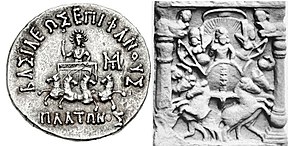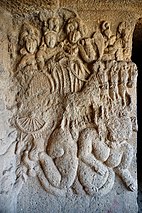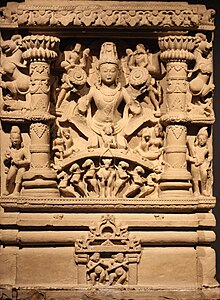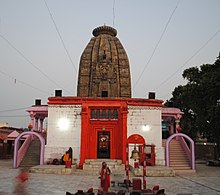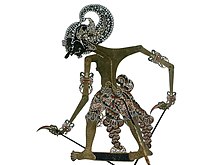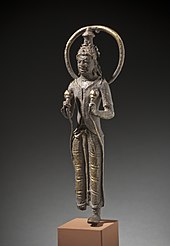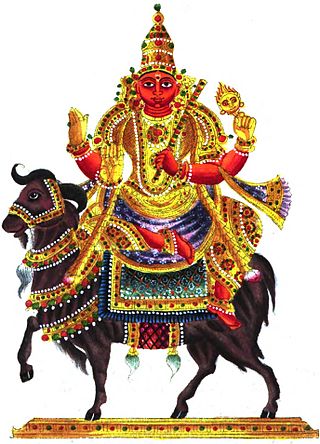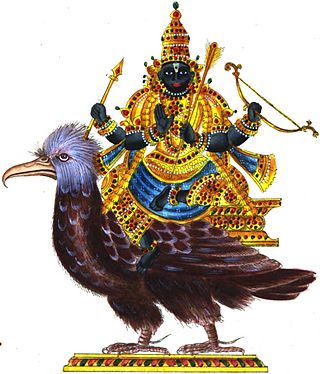| Surya | |
|---|---|
| Member of Navagraha | |
 Painting of the god Surya, 19th century | |
| Other names | Aditya, Surājā, Bhaskara, Bhanu, Divakara, Suryanarayana, Ravi, Kathiravan, Prabhakara, Vivasvan, Savitr |
| Affiliation | Deva, Adityas, Navagraha |
| Abode | Suryaloka |
| Planet | Sun |
| Mantra |
|
| Weapon | Suryastra, Astras, Wand, Trisula, Chakra, Gada and Conch Shell |
| Day | Sunday |
| Number | 1 |
| Mount | Chariot drawn by seven horses Charioteer: Aruṇa [2] |
| Festivals | Pongal, Sankranti, [3] Chhath |
| Personal information | |
| Parents | |
| Siblings | Indra, Agni, Vayu, Varuna, Vamana, Bhaga, Aaryaman, Mitra |
| Consorts | Sanjna and Chhaya; Rajni and Prabha/Nikshubha (in some scriptures) [4] [5] [6] |
| Children |
|
| Equivalents | |
| Greek equivalent | Helios [7] |
| Roman equivalent | Sol |
| Norse equivalent | Sól |
| Indo-European equivalent | Sehul |
| Egyptian equivalent | Ra [8] |
| Part of a series on |
| Hinduism |
|---|
 |
Surya ( /ˈsuːrjə/ ; [9] Sanskrit : सूर्य, IAST : Sūrya) is the Sun [10] as well as the solar deity in Hinduism. [10] He is traditionally one of the major five deities in the Smarta tradition, all of whom are considered as equivalent deities in the Panchayatana puja and a means to realise Brahman. [11] Other names of Surya in ancient Indian literature include Aditya, Arka, Bhanu, Savitr, Pushan, Ravi, Martanda, Mitra, Bhaskara, Prabhakara, Kathiravan, and Vivasvan. [12] [13] [14]
Contents
- Texts and history
- Vedic
- Epics
- Iconography
- Buddhism and Jainism
- Hinduism
- Astronomy
- Zodiac and astrology
- Temples and worship
- Dedicated temples
- Surya temples outside India
- In cultures, arts and other religions
- Festivals
- Dances
- Yoga
- Buddhism
- Outside the Indian subcontinent
- Indonesia
- Gallery
- See also
- References
- Cited sources
- Further reading
- External links
The iconography of Surya is often depicted riding a chariot harnessed by horses, often seven in number [2] which represent the seven colours of visible light, and the seven days of the week. [12] [15] During the medieval period, Surya was worshipped in tandem with Brahma during the day, Shiva at noon, and Vishnu in the evening. [12] [16] In some ancient texts and art, Surya is presented syncretically with Indra, Ganesha, and others. [12] [15] Surya as a deity is also found in the arts and literature of Buddhism and Jainism. In the Mahabharata and Ramayana, Surya is represented as the spiritual father of Rama and Karna (protagonists of the Ramayana and the Mahabharata, respectively). Surya was a primary deity in veneration by the characters of the Mahabharata and Ramayana, along with Shiva. [17] [18]
Surya is depicted with a Chakra, also interpreted as Dharmachakra . Surya is the lord of Simha (Leo), one of the twelve constellations in the zodiac system of Hindu astrology. Surya or Ravi is the basis of Ravivara, or Sunday, in the Hindu calendar. [19] Major festivals and pilgrimages in reverence for Surya include Makar Sankranti, Pongal, Samba Dashami, Ratha Saptami, Chath puja, and Kumbha Mela. [20] [21] [22]
He is particularly venerated in the Saura and Smarta traditions found in Indian states such as Rajasthan, Gujarat, Madhya Pradesh, Bihar, Maharashtra, Uttar Pradesh, Jharkhand, and Odisha.
Having survived as a primary deity in Hinduism longer than any most of the original Vedic deities, the worship of Surya declined greatly around the 13th century, perhaps as a result of the Muslim destruction of Sun temples in North India. New Sun temples virtually ceased to be built, and some were later repurposed to a different deity. A number of important Surya temples remain, but most are no longer in worship. In certain aspects, Surya has tended to be merged with the prominent deities of Vishnu or Shiva, or seen as subsidiary to them. [23]
